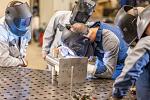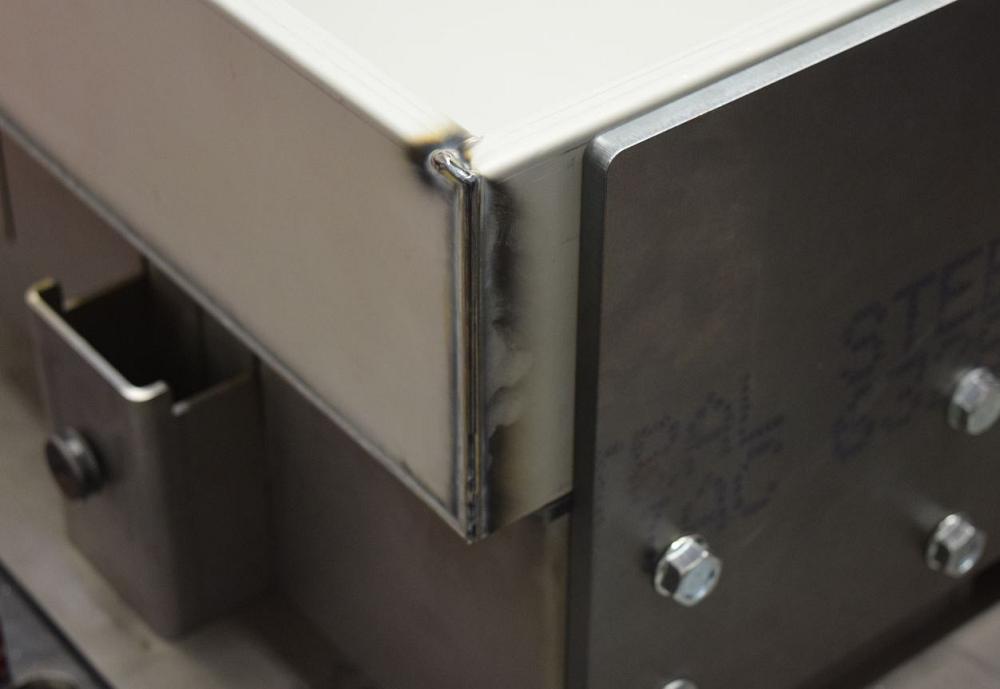- FMA
- The Fabricator
- FABTECH
- Canadian Metalworking
Amada’s Innovation Expo highlights time-saving software, laser welding, robotics
- September 26, 2016
- News Release
- Fabricating

Attendees of Amada's Innovation Expo examine a weld completed on the FLW 4000 fiber laser welding system.
On September 21-22, Amada welcomed more than 200 customers to its Schaumburg, Ill., facility for its Innovation Expo. The event highlighted advanced digital processing technologies, automated bending processes and the design and processing of parts for laser welding. It highlighted the ways in which shops of all sizes need to consider how they will adapt to demands for higher precision part specifications and finished part quality.
Virtual Production Sorts out Part Processing
The full floor of machines included the advanced digital processing capabilities of the company’s VPSS (Virtual Prototype Simulation System) 3i software. This software was the behind-the-scenes star of the whole Expo. The information that is included in the VPSS 3i software includes data from all of Amada’s machines. Thus, the software isn’t simply concerned with individual production concerns, such as cutting, bending or welding. The software considers all steps in the production process and considers the best way in which to process a part before a piece of sheet metal even gets near a machine.
As an example of the adaptability of the software, attendees were given a demonstration of how it changes a part’s parameters if it is going to be laser welded rather than going through a GMAW or GTAW process. In this case, an electrical enclosure was processed, and the design was optimized using a mortise and tenon joint to reduce fixturing during the welding process.
This was followed by a walk-through of each process in the making of the part in question on Amada’s verification floor. During this, customers saw the LC 2515 C1 AJ punch/fiber laser system at work, as well as the HG 8025 press brake, and the FLW 4000 fiber laser welding system.
Rotating Lens Adds Capability to Laser Welder
Perhaps the most interesting innovation included on the FLW is its patented rotating lens. As the company explains it, the use of this lens means that the laser beam is not aligned on a specific point along the target path. Instead, it circles a small area as it welds. This allows it to bridge larger and uneven gaps while producing a clean weld.
Daniel Belz, product manager, fiber welding, noted that a product such as the electrical enclosure could take as much as 10-20 minutes to weld by hand, plus post-processing. The use of a laser welder can reduce that time to just a few minutes, and post-processing can be virtually eliminated. The key is ensuring that the job in question warrants a laser welder.
Adaptable Integrated Bending
With the advances in software capabilities in the past few years, having one person bending parts on a press brake has become a new bottleneck in parts processing. The Expo highlighted the variety of options now available to solve that problem for parts of all sizes.
The HG 1303 RM robotic compact bending system, for instance, is designed for processing large parts that would normally require two operators. The robot handles parts up to 176 lbs. and sheet sizes up to 8.20 ft. by 4.10 ft. The system includes an integrated bend indicator sensor for angle accuracy.
The HG 1003 ARs integrated bending system, on the other hand, is equipped with an automatic tool changer (ATC). The ATC is equipped with 18 magazines for dies and 15 for punches, which means that the machine can be quickly switched out for rush jobs or small production runs.
Lastly, the EG 6013 AR robotic bending cell demonstrates how difficult-to-manage small and complex parts can be processed without operator interference. The brake is equipped with a twin servo electric drive system for high-speed and high-accuracy bending and lower power use. It includes multiple part load/unload stations and an automatic tool changer, as well as automatic angle measuring.
The Innovation Expo was a great indication of how advanced fabricators can now streamline parts processing and eliminate manual part measurement and finishing. The fact that this is now possible in high mix, low volume parts-producing shops is what makes it particularly exciting.
subscribe now


Keep up to date with the latest news, events, and technology for all things metal from our pair of monthly magazines written specifically for Canadian manufacturers!
Start Your Free Subscription- Trending Articles
Class is in session for college connections

BlueForge Alliance partners with Nuts, Bolts & Thingamajigs to develop Submarine Manufacturing Camps

Portable system becomes hot tech in heat treatment

Orbital tube welding webinar to be held April 23

Cidan Machinery Metal Expo 2024 to be held in Georgia May 1-2

- Industry Events
MME Winnipeg
- April 30, 2024
- Winnipeg, ON Canada
CTMA Economic Uncertainty: Helping You Navigate Windsor Seminar
- April 30, 2024
- Windsor, ON Canada
CTMA Economic Uncertainty: Helping You Navigate Kitchener Seminar
- May 2, 2024
- Kitchener, ON Canada
Automate 2024
- May 6 - 9, 2024
- Chicago, IL
ANCA Open House
- May 7 - 8, 2024
- Wixom, MI
















